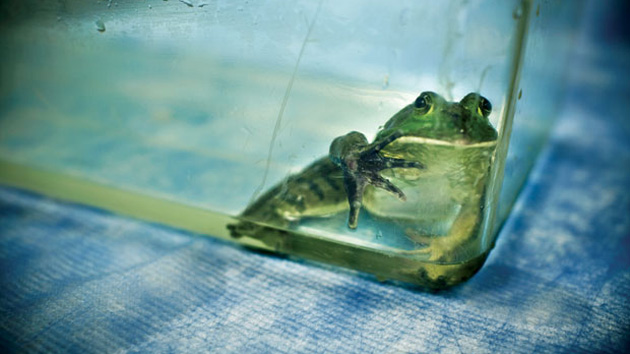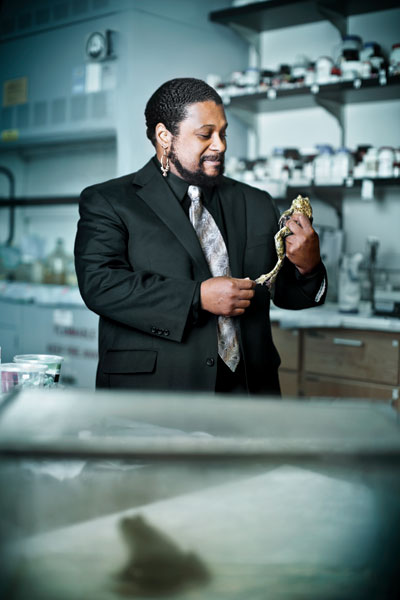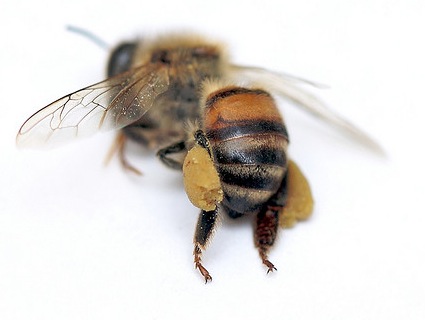
This frog isn't Darnell, or even Xenopus. It's another species studied in Hayes' lab.Annie Tritt
Darnell lives deep in the basement of a life sciences building at the University of California-Berkeley, in a plastic tub on a row of stainless steel shelves. He is an African clawed frog, Xenopus laevis, sometimes called the lab rat of amphibians. Like most of his species, he’s hardy and long-lived, an adept swimmer, a poor crawler, and a voracious eater. He’s a good breeder, too, having produced both children and grandchildren. There is, however, one unusual thing about Darnell.
He’s female.
Genetically, Darnell is male. But after being raised in water contaminated with the herbicide atrazine at a level of 2.5 parts per billion—slightly less than what’s allowed in our drinking water—he developed a female body, inside and out. He is also the mother of his children, having successfully mated with other males and spawned clutches of eggs. Recently he was moved to an atrazine-free tank and has turned lanky, losing the plump, pincushion look of a female frog. But last March, when UC-Berkeley integrative biology professor Tyrone B. Hayes opened him up to take a look, Darnell’s insides were still female. “He still has ovaries, but there’s no eggs in them,” Hayes told me the next day as we stood watching the frog, who swam over and inspected us soberly, then turned and flopped away.
Hayes is a 5-foot-3 fireplug of a man with a gentle voice and an easy grin who favors black suits when he’s on the lecture circuit and sweatshirts and running shorts the rest of the time. He is an unusual breed. You will find few other faculty members who keep their money and identification in a child’s Spider-Man sock rather than a wallet, or run their daily 12-mile commute, or compose raps about their research and perform them at scientific meetings. The pool of endocrinologists and herpetologists who might casually mention lunching on homemade raccoon curry is also minuscule. And most scientists, upon discovering that trace amounts of one of the nation’s top-selling herbicides cause gender-bending abnormalities in frogs, would have been content to publish their results and let the regulators and manufacturers fight it out.
But Hayes is not like other scientists. To be sure, he publishes in all the right journals and presents his work at the key scientific meetings, but he has also spearheaded a public outcry against atrazine, testifying at government hearings, appearing in all forms of media, and even launching AtrazineLovers.com, an anti-atrazine website.
All of this has earned Hayes something approaching rock-star status. He has been the subject of a children’s book (The Frog Scientist), travels the world giving lectures, and by his estimate has appeared in a dozen documentaries. And while scores of researchers have described atrazine’s worrisome effects, it is Hayes’ knack for drama that has brought attention to the problem. Without him, atrazine might not be undergoing its third Environmental Protection Agency review in less than a decade, and Syngenta, the chemical’s Swiss manufacturer, might not be facing lawsuits in state and federal courts by plaintiffs from 40 Midwestern water districts who claim atrazine has contaminated their drinking water. “He’s a remarkable person,” says David Skelly, a Yale ecologist who has served on two of the advisory panels that help the EPA vet atrazine research. “And he’s become the personality associated with this issue because he’s a remarkable person.”
Yet over the years, Hayes has become engaged in a remarkably antagonistic sort of symbiosis with Syngenta. Company reps trail him from one speaking engagement to the next; Hayes, in turn, bombards Syngenta with a steady flow of emails laced with profane verses, academic taunts, and even accounts of his dreams. When a batch of these emails became public in 2010, Hayes’ supporters and critics alike were stunned. Here was one of the top scientists in his field, provoking one of the world’s largest agrichemical companies with crude sexual innuendos and LL Cool J-inspired raps:
tyrone b hayes is hard as hell
battle anybody, i don’t care who you tell
you object! you will fail!
mercy for the weak is not for sale
“It hasn’t been productive in the debate, and it hasn’t helped him,” Skelly says. “I mean, why do that?”
Born in a colored hospital in Columbia, South Carolina, in 1967, Hayes grew up catching lizards, frogs, and turtles in the swamps near his grandmother’s house, which sat on land where his ancestors once toiled as slaves. He was, admittedly, “a weird kid” who raised tadpoles in wading pools and set up bird blinds based on the ones he’d seen on Mutual of Omaha’s Wild Kingdom, wearing pots on his head to fend off jay and dove attacks while he filmed their nests. He would memorize the Latin names of South Carolina beetles in his grandmother’s field guides and draw pictures of animals, people, and sci-fi characters.
Hayes’ father, Romeo, was a carpet installer who never finished high school, and Hayes, too, struggled in school, largely because he was bored. “I finished all the math books by third grade and most of the reading books,” he recalls. “So I was considered disruptive.” By middle school, his artistic talents had attracted the notice of his teachers, who placed him in classes for gifted students. But it was science that dominated his thoughts. He spent hours with chameleonlike lizards called anoles, trying to understand what made them change color. He warmed them with a blow-dryer to see if it was heat, sheltered them in a doghouse to see if it was light, and found at last that the creatures had to be awake to color-match, a discovery that won him a state science fair prize. Later, when it came time to think about college, Hayes applied only to Harvard, because he’d heard the name on Green Acres. He got in.
The Ivy League proved a tough transition. At an undergraduate mixer his first day at Harvard in 1985, Hayes recalls introducing himself to a white student who looked at his outstretched hand and said, “It was because of affirmative action that I was wait-listed here.” He felt isolated, drank too much, and thought about dropping out. But he gained his bearings with the help of amphibian expert Bruce Waldman, who mentored him, and his girlfriend Kathy Kim, who would become his wife and the mother of his two children. In the end, he graduated summa cum laude in biology. “It was the worst four years of my life,” he says now. “But if I could do it all over again, I’d do it exactly the same.”
After that rocky start, Hayes’ rise was meteoric. He earned his Ph.D. in integrative biology from UC-Berkeley in just three and a half years. Less than a year later the university hired him as an assistant professor—he would soon become the second-youngest tenured professor in his department’s history. Hayes might easily have spent his career as an obscure if well-regarded authority on the endocrine systems of frogs had not his work attracted the attention of a consulting firm called EcoRisk*, which sought him out to evaluate atrazine’s effects on amphibians.
 Tyrone Hayes confronts one of his research subjects at his UC-Berkeley laboratory. Annie TrittAtrazine has long been a mainstay of American agriculture. Registered for use in 1959, it is now used on half the nation’s corn and 90 percent of our sugarcane, not to mention lawns, golf courses, and Christmas tree farms. All told, about 80 million pounds of it are applied each year, making it the most widely used herbicide after glyphosate, a.k.a. Roundup. While Syngenta, the largest producer, won’t disclose its profits from atrazine, the company earned $2.3 billion in 2010 from its line of selective herbicides (those that only kill specific plants), of which atrazine is the leading product. Sales keep rising as more weeds develop resistance to Roundup: Syngenta reported a 14 percent bump in the first half of 2011.
Tyrone Hayes confronts one of his research subjects at his UC-Berkeley laboratory. Annie TrittAtrazine has long been a mainstay of American agriculture. Registered for use in 1959, it is now used on half the nation’s corn and 90 percent of our sugarcane, not to mention lawns, golf courses, and Christmas tree farms. All told, about 80 million pounds of it are applied each year, making it the most widely used herbicide after glyphosate, a.k.a. Roundup. While Syngenta, the largest producer, won’t disclose its profits from atrazine, the company earned $2.3 billion in 2010 from its line of selective herbicides (those that only kill specific plants), of which atrazine is the leading product. Sales keep rising as more weeds develop resistance to Roundup: Syngenta reported a 14 percent bump in the first half of 2011.
In 1997, EcoRisk approached Hayes on behalf of Syngenta’s corporate predecessor, Novartis. They wanted him to study atrazine, which at the time was going through a product reapproval process mandated by the EPA. Hayes took the gig, figuring Novartis wouldn’t ask him to look into the herbicide’s effects if it expected him to find anything. “My hypothesis was, nothing’s going to happen,” he recalls.
Yet something did. In his experiments, male Xenopus exposed to atrazine had shrunken voice boxes, which put them at a disadvantage for courting females. That was startling enough. But when Hayes examined the frogs’ gonads, he discovered something more disturbing: About a third of the exposed males had malformed reproductive organs. Many were hermaphrodites, with both ovaries and testes. Some had more than two of each organ—and some of the testes produced eggs instead of sperm.
Xenopus are not naturally hermaphroditic, and no intersex frogs were found in Hayes’ control tanks. But gender deformities were present among frogs exposed to as little as 0.1 part per billion (picture a thousandth of a grain of salt in a half gallon of water). That’s 30 times less than the 3 ppb the EPA allows in our drinking water.
Since 1980, scientists had been reporting shrinking amphibian populations—close to one-third of known species are now in danger of extinction. Hayes was intrigued to think he might have discovered a cause for the decline. “Everybody is out there looking for dead frogs and what killed the frogs,” he explains. “We’re asking, ‘How come there aren’t any new frogs?’ Atrazine isn’t killing the frogs. But if they’re reproductively impaired, that’s killing the population.”
To Hayes’ surprise, EcoRisk and Novartis didn’t seem as concerned about his findings as he was. He was asked to repeat the studies but wasn’t given the necessary funding, he says, and EcoRisk scientists suggested statistical manipulations that made the voice box effect appear to vanish. Hayes weighed simply handing over his data. After all, this was contract work. “It’s just like if I was an artist and you told me to paint you this color, and I paint you that color and you buy the painting and I’m done with it,” he says.
In the end, he couldn’t do it. In 2000, he resigned from the panel of scientists working for EcoRisk. He then repeated the experiment, twice, and in April 2002 published his findings in the Proceedings of the National Academy of Sciences. He has since published a dozen atrazine papers in peer-reviewed journals and replicated his findings with two other frog species, both in the lab and in nature. One study, published in pnas in 2010, found that when 40 male Xenopus hatched in water contaminated with atrazine at a level of 2.5 ppb, three-quarters wound up chemically castrated or partially feminized; four, like Darnell, changed genders completely. He has also tracked a population of leopard frogs in a Wyoming pond for a decade, documenting how the ratio of males to females rises and falls in tandem with atrazine levels.
Hayes postulates that atrazine affects gender by activating a gene that produces an enzyme called aromatase, which converts androgens—male sex hormones—to estrogens. In his talks, he makes sure to point out that estrogen is the same in frogs and humans. Just like frogs, we begin our development steeped in an aqueous environment: amniotic fluid. The chemical that so powerfully alters the gonads of a frog may be having an effect on us, too.
As assiduously as Hayes researches links between atrazine and hermaphroditic frogs, Syngenta attempts to disprove them, funding a stream of research that has found, variously, that atrazine exposure did not produce intersex frogs, that intersex frogs can be found regardless of atrazine exposure, and that atrazine exposure produces intersex frogs only at very high concentrations. “No reliable, replicable studies have ever linked atrazine to effects on frog sexual development,” Syngenta spokeswoman Ann Bryan told me via email, noting that previous EPA reviews have determined that “atrazine does not adversely affect amphibian gonadal development.” (Syngenta officials declined to be interviewed but agreed to answer a few written questions.)
Actually, atrazine’s unintended effects are documented in dozens of peer-reviewed studies. Last year, Jason Rohr and Krista McCoy from the University of South Florida published a meta-analysis of research involving amphibians and fish and found consistent results indicating that the herbicide affects the reproductive and immune systems. This past year, Hayes gathered 21 coauthors for a paper in the Journal of Steroid Biochemistry and Molecular Biology showing that atrazine disrupts normal hormonal function, with demasculinizing effects on male gonads in reptiles, fish, amphibians, and mammals. He and 40 coauthors from 13 countries will soon publish a literature review that reaches similar conclusions. “I’ll have every scientist, with a few exceptions, who has worked on atrazine saying, ‘We’re together,'” he promises.
Perhaps if Syngenta had simply questioned Hayes’ research in academic journals, things might have stayed focused on questions of sample sizes, lab conditions, and so on. But the company began sending staff to Hayes’ research talks in the United States and abroad, where he says they sometimes passed out materials disparaging his methods and accusing him of fabricating results or refusing to share data. “A Syngenta representative does try to attend events where Dr. Hayes is speaking,” Syngenta’s spokeswoman confirmed. “It’s in our best interest, and farmers’, that we have the opportunity to counter his outrageous accusations.”
Over time, these tense interactions escalated into the kind of verbal jostling you’d expect in a high school hallway. Syngenta officials, according to Hayes, have made derogatory remarks about his appearance, his speaking style, and even his sexual proclivities, which sounds implausible until you consider that Syngenta’s PR firm, Jayne Thompson & Associates, once proposed a covert media campaign to discredit the court system in an Illinois county where judges are presiding over an atrazine lawsuit.
At one conference in 2005, he contends, Syngenta staff scientist Tim Pastoor accused him of “cherry-picking data” and asked if he cherry-picked his dates as well. Hayes responded in an email: “don’t worry…daddy has no intentions of picking your cherry.” At another meeting, Pastoor asserted that atrazine was a vital tool for US farmers. Hayes emailed him to ask, “How long have YOU been a ‘vital tool’?” adding, “I’ve got your vital tool right here.”
While there was a certain frat boy humor to this scientific smack talk, there was also an element of psychological warfare. After Hayes gave a lecture at the Society of Environmental Toxicology and Chemistry confab in 2007, he received an email from Syngenta scientist Alan Hosmer, whom he knew from his EcoRisk days: “You lost and everyone at SETAC was calling you an entertaining fraud,” Hosmer wrote.
Hayes felt the message was designed to arouse a black academic’s worst anxieties: the fear of being seen as a buffoon or an affirmative-action mistake. This time, Syngenta reps received a six-page email response titled: “I OWN THIS: A MADMAN’S MANIFESTO.” In it, Hayes bragged of his fame (“I get paid $10,000 for talking for an hour”), ridiculed Syngenta’s research (“nothing you have done can touch the quality of my work”), and waxed poetic about how his kids attend the fancy “white private schools” that were unavailable to him. He also deployed his favorite phrase—”I don’t give a fuck”—shortened to an acronym: “IDGAF! Come on?????…do you think I care about propriety and professionalism?…I have used the ‘F-word’ in my talks, have quoted DMX, Busta Rhymes, Tyra Banks, Marvin Gaye…I pack the room, have em’ call out security…and have been invited back every year. That’s my house, Trick!”
Things came to a head in February 2010, when Syngenta’s Pastoor buttonholed Hayes in the Illinois Statehouse as Hayes prepared to testify before an Assembly committee. “Who’s taking care of your family and your lab when you’re traveling so much, Tea Bag?” Pastoor allegedly said. “Don’t you worry about that?” The episode ended, Hayes claims, with Pastoor saying: “Next time you give a talk, I’m going to bring some of my good old boys and let you tell them how atrazine is making them gay. That should be fun. How about that, Tea Bag?”
Hayes was mystified: Was Pastoor referring to his initials, T.B. Hayes, or to the sexual act known as “teabagging”? Either way, he saw it as an effort to unnerve him prior to his testimony. “He wants me to think that if I go out for a run tonight, some people in a pickup truck are going to come,” he says. Pastoor did not respond to my requests to get his side of the exchange; Syngenta’s spokeswoman replied that “Dr. Hayes’ unfounded allegations are not relevant to serious scientific or public policy discussions.”
Hayes dashed off a furious rhyming response to Pastoor, Hosmer, and Syngenta attorney Alan Nadel. The next day, a message from Nadel to Pastoor landed back in his mailbox, clearly cc’d by accident: “Tim: I think you did hit a nerve. Alan.” Hayes took it as proof that Syngenta officials were plotting to get under his skin. “They’re probably Googling: ‘Things that black people don’t like to hear,'” he says.
A cooler head might have filed the emails away and gone back to his frogs. But Hayes was infected by an acute case of esprit d’escalier. He continued bombarding his nemeses with hip-hop battle taunts until that July, when Syngenta filed an ethics complaint with UC-Berkeley charging that the emails were not only “aggressive, unprofessional and insulting, but also salacious and lewd.” It also went public with 102 pages of Hayes’ emails. Exhibit A:
ya outa’ luck…bouta show you how it is right now
see you’re ****ed…(i didn’t pull out) and ya fulla my j*z right now!
The messages went viral, lighting up the blogosphere with headlines like “Dr. Tyrone Hayes: Biologist, Cock-Fixated Megalomaniac Email Addict” (Gawker) and “Berkeley Scientist Gets Gully in Emails to Shady Pesticide Company ‘I Ain’t Scared O’ You Mofos‘” (Bossip). The New York Times and Science wrote about the scandal, as did the esteemed journal Nature—which has published Hayes’ work.
“I spent a week in bed with a stomachache,” Hayes recalls, mainly because he was worried how it would look to the foundations he relies on for research money—not that he would ever take the emails back. His critics were ecstatic. Googling “Dr. Tyrone Hayes” now returns paid results from groups like AgSense, an agribusiness coalition that leads its critique of Hayes by quoting his “propriety and professionalism” outburst. Alex Avery, who created an anti-Hayes video as part of his work with the Center for Global Food Issues, an anti-organics think tank, also quoted the emails, asking, “What does it take for a scientist to be discredited?”
More than this, apparently. The university’s chief counsel ruled that no ethics violation had occurred but admonished both sides to behave. “We told him that his communications have the potential to reflect poorly on him and diminish the impact of his research-based arguments,” says Mark Schlissel, Hayes’ former dean. “He said he understood that.” Sixteen scientists from a variety of disciplines wrote to the university in support of Hayes, casting Syngenta’s move as a diversionary tactic. Others tried to distinguish between the messages and the messenger. “Science with an attitude is still science. Its validity doesn’t depend on whether you like the behavior of an individual scientist,” wrote environmental economist Frank Ackerman in a widely circulated Grist article.
Privately, though, Hayes’ allies were aghast. His irreverence had always been an asset, attracting attention to atrazine just as Rachel Carson’s impassioned lyricism drew attention to DDT. But now irreverence had tipped toward irrationality. “Ultimately, as scientists, we have to sell our research and make sure that people are aware of it,” says Jason Rohr, the researcher who did the meta-analysis. “But we also have to be objective.”
When I ask Hayes what possessed him to engage with Syngenta in this particular way, he’s silent for a moment. “Wow, that’s probably a long conversation,” he says. The answer is related to his motto: IDGAF. For him, not giving a fuck means refusing the Faustian bargain that in exchange for a shot at professional respect you have to leave your true self at home. In his youth, Hayes told me, he hadn’t even wanted to sign his full name to his paintings, because Tyrone was such a stereotypically black name. But that kind of cultural inauthenticity, he now believes, embodies the same sort of dishonesty that allows someone to fudge data on a contract job. “How can you be one person in your personal life and another in your professional life?” Hayes asks.
Now that he’s tenured, the facade is no longer necessary. He can rap. He can cuss. And if anyone wants to question his legitimacy, “I’m coming at you, and I don’t care who knows it.” That’s more or less what he means when he signs his Syngenta emails “my name is tyrone.”
It’s been about 18 months since the email uproar, and Hayes has concluded that it has helped him more than it hurt. “Thanks to their advertising,” he gloats, “I’m giving 129 talks in the next year.” It has also brought his work to new audiences via pop-culture blogs. “Now I’ve got minorities who would never have had access to this information,” he says. And that’s important because minorities are most at risk of exposure; half of America’s farmworkers are Hispanic, according to the USDA. “They have levels of atrazine in their urine that are 24,000 times what we use in our laboratory,” Hayes adds.
In 2009, a New York Times investigation found that 33 million Americans are exposed to atrazine through drinking water. EPA data from 2010 shows contamination exceeding the federal limit in 9 out of 10 states monitoring it—several Midwestern water districts reported between 9 and 18 times the limit. (Atrazine’s tendency to contaminate water supplies is one reason the European Union voted to ban it in 2003.)
The EPA has claimed these spikes are not a health hazard. Yet epidemiological studies have found links between prenatal atrazine exposure and birth defects, premature birth, and low birth weight—even at extremely low concentrations. As Hayes explains, “0.1 ppb is not a low dose at all. Estrogen is active at levels that are 100 to 1,000 times lower than that. So in terms of an endocrine disruptor, that’s a high dose.”
The EPA is weighing this argument as it reconsiders whether to ban or restrict atrazine. In July, its advisory panel, citing “strong” epidemiological evidence, criticized the agency for understating the chemical’s carcinogenic potential. But with the EPA’s review of the science now headed into its fourth year, Hayes doesn’t expect much in the way of decisive action. Back in 2005, the Natural Resources Defense Council obtained documents revealing that agency officials met privately with Syngenta more than 40 times while evaluating atrazine’s toxicity. The Huffington Post Investigative Fund reported that fewer than 20 percent of the papers the EPA relied upon in its past decision-making were peer-reviewed, while at least half were conducted by scientists with a financial stake in the product.
The other reason Hayes is skeptical involves the power of the corn lobby. Corn farmers like atrazine because it increases yields and lets them cut back on plowing, reducing erosion. “Frogs are doing quite fine in Kansas,” says Jere White, head of the Kansas Corn Growers and Kansas Grain Sorghum Producers Associations. “Anecdotally, I’d say they must not have read Dr. Hayes’ studies.”
Hayes is working on several new papers, including one he contends will be his most disturbing yet. It will show that male frogs exposed to atrazine early in life have feminized brains and tend to assume the bottom position when copulating, even when placed in a tank with females. While these frogs lack female sex organs, Hayes explains, their hormonal profile looks female, and “they have an identity that says female.”
The last time we spoke, Hayes was getting ready to shoot Syngenta an email announcing his upcoming publications. “I think it’ll just be informative,” he told me. “Just to let them know. That’s why they call me Tyrone.”
*Correction: The original version of this article, which also appeared in our January/February 2012 print edition, misidentified the consulting company that hired Hayes as Pacific EcoRisk, and mistakenly linked to the homepage of that company. The company Hayes actually worked for, EcoRisk, no longer exists.














